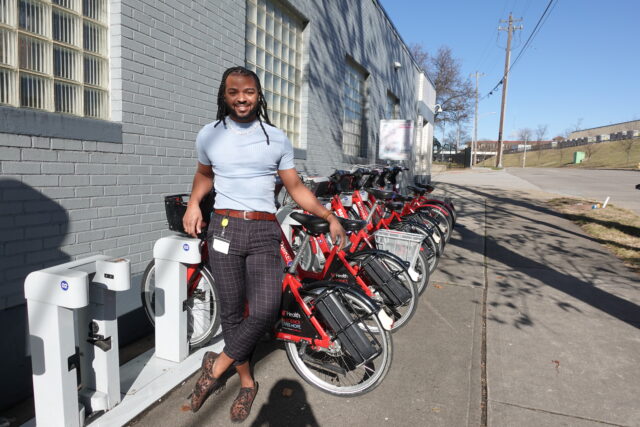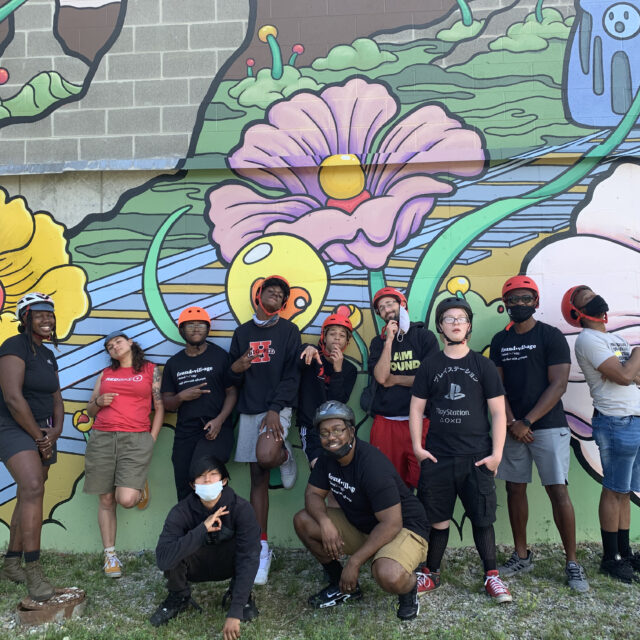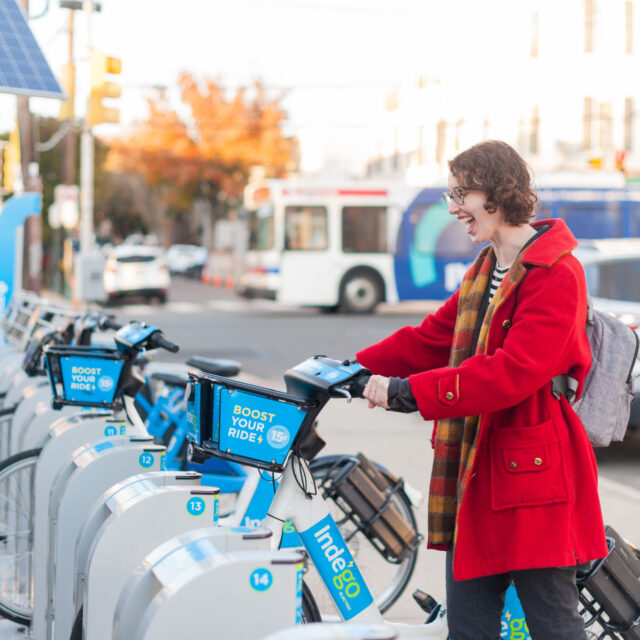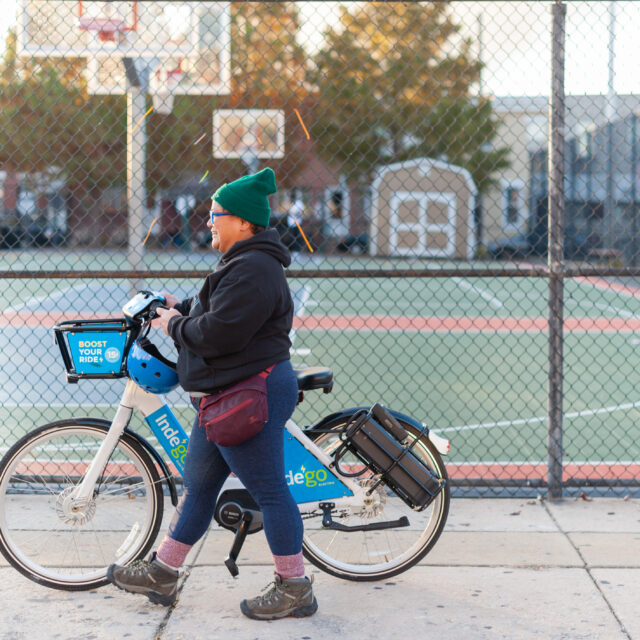How Partnering With a Homeless Shelter Can Benefit Bike Share
by Kiran Herbert, Communications Manager
March 6, 2023
Cincy Red Bike partnered with Shelterhouse, a local community organization for the unhoused. The resulting station is among the system’s most used.

Shelterhouse Executive Administrative Assistant Lahray Curtis poses with the organization’s bike share station.
Cincy Red Bike, the public bike share system that serves Cincinnati, Ohio, and parts of nearby Northern Kentucky, has always put equity at the forefront. Not only does it accept cash payments but its low-income Go Pass program, which launched in 2018, is one of the most successful in the country, with Go members taking about 23% of all Red Bike rides in 2022. The system is also one of our five Living Labs, having dedicated more than two years and $200,000 in funding to engaging a new generation of riders and intentionally expanding its system footprint.
A key part of all of Red Bike’s work is building strong relationships with non-endemic community-based organizations. One of those is Shelterhouse, a nonprofit that serves the unhoused and/or transient individuals and is based just down the road from Red Bike’s headquarters. Shelterhouse houses around 210 folks every day and in addition to providing a safe place to land, offers a variety of different services, including medical and mental healthcare, as well as case management.
“For a long time, we were talking with Shelterhouse about the ways we could possibly work with them,” says Elese Daniel, education and outreach manager at Red Bike. “We’d worked with them on some smaller partnerships but were often finding bikes outside the shelter. Their priority was getting a station.”
Heeding its partner’s wishes, Red Bike installed an 11-dock station at Shelterhouse in August of 2022. In its first month alone, the station saw more than 300 trips, the highest of any station within the Red Bike system. Despite opening late in the summer, it was the fifth most-used of all Red Bike’s stations in 2022 and the most-used amongst Go members.
“It has been used substantially in just the handful of months that it has been online,” says Daniel. “It speaks to how bike share is an essential service that people actually need and use.”
The station is also a testament to how strong, community-based partnerships are critical to the success of bike share and how bikes are critical to expanding people’s mobility options. Rather than starting from scratch to build confidence and relationships with a new demographic, Red Bike was able to work with Shelterhouse, who already had the trust of Cincinnati’s unhoused and transient populations, building off of their success to ultimately benefit a key demographic: People in need of transportation.
“There are so many organizations and groups connected to the communities that we want to serve already, so it’s just about tapping into them and building something together,” says Daniel, noting that it’s important to not put too much of a lift on the organizations you’re working with. “We’re trying to build programming within our partnerships that are most helpful for the end rider and aren’t too taxing for anyone involved.”
According to Mikaela Pellerin, Red Bike’s membership and communications manager, a survey of Go members highlights how they’re primarily using bike share to commute to school and work, as well as make transit connections. Many Go members also said that Go Bike is getting better at serving the needs of people like them. This jives with what Lahray Curtis, Shelterhouse’s executive administrative assistant, has seen to be true.
“[The Shelterhouse clients] just didn’t have that connection before to get to work,” says Curtis. “We do give them bus passes, but now there are Red Bikes on the street — like, ‘Oh you know what, I can ride this Red Bike and get to Covington, [Kentucky,] and get to McDonald’s or Chipotle. I can get to work and come straight back to the shelter.’”
While Curtis knew the station would see traction, he’s been pleasantly surprised by how popular it is amongst Shelterhouse clients as well as staff. To help spread the word, Shelterhouse has fliers posted on its bulletin boards with all the pertinent information and its receptionists have Red Bike as an item on their check sheets for newcomers. Thomas Gholston, a Shelterhouse client who’s been using Red Bikes since the station launch, credit bike share with helping him to become more mobile.
“I was at the Shelterhouse and I didn’t have any other means of transportation,” says Gholston. “At one point I was using it to go all the way up Linn Street to Dayton Avenue. Now I’m using it to catch a bus to work in the morning and on the way back I take Red Bike from Government Square.” For Gholston, using bike share to connect to transit has been a game-changer, although he still wishes there were more stations outside of downtown and areas that aren’t particularly close to bus lines. “It’s a very economical way for people to get around without other transportation options,” says Gholston. “Sometimes you have to have transportation to get to a bus line.”
Gholston has back issues and prefers riding over walking — he’s especially keen on the system’s electric bikes, which make commuting even easier. Devont Yarbrough, another Shelterhouse client and Go member, also prefers the e-bikes. He mostly uses them to go downtown and to the Clifton neighborhood.
“I do it to get around easier and cheaply,” says Yarbrough. “And for exercise.”
The only complaints Red Bike has received revolve around keeping the e-bike batteries charged, especially as they tend to see much more use (in 2022, e-bikes made up just a third of Red Bike’s fleet but accounted for 70% of the total rides and 80% of Go member trips). Still, unlike many other systems, the e-bikes and normal bikes cost the same — $5 a month — for Red Bike Go Pass members.
“We’re not trying to make money,” says Pellerin, noting how the new Shelterhouse station is about using bikes to create more opportunity for people. “We’re just trying to help people and serve their needs.”
The Better Bike Share Partnership is funded by The JPB Foundation as a collaboration between the City of Philadelphia, the National Association of City Transportation Officials (NACTO), and the PeopleForBikes Foundation to build equitable and replicable bike share systems. Follow us on LinkedIn, Facebook, Twitter, and Instagram or sign up for our weekly newsletter. Got a question or a story idea? Email kiran@peopleforbikes.org.



